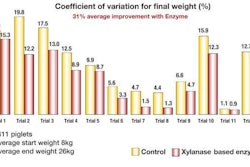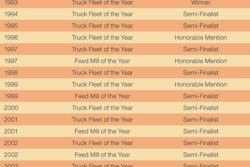Grain prices have made bigger headlines, but the escalation in the price of milk products since the middle of last year has had more impact on the European market for young-animal diets. One specialist manufacturer of piglet feeds in Europe has responded by offering customers the choice between its regular formulation and a less-cost alternative.
New lower-cost diets
The announcement by Primary Diets in the UK referred to the launch as a reaction to the poor economic circumstances besetting the British pig industry. The new Topspec range of lower-cost diets – resulting from research and development work carried out in conjunction with the University of Leeds – made use of the latest protein and energy sources to reduce reliance on costly milk products, while maintaining the best possible nutrition for piglets.
Primary Diets is part of feed group Associated British Nutrition (ABN), which sponsors the British Pig & Poultry Fair trade show in May and plans to highlight the new range at the event. There are already indications that sow-herd operators in the UK have taken a slightly different stance on piglet feed usage than is seen in some other countires in Europe currently.
In Germany, sales of piglet starter diets have held firm despite their rising price. Spain has represented the other extreme by cutting back dramatically on the amounts used. Denmark had already adjusted quality downwards over the last two years as weaning age was extended from 3.5 to 4 weeks to 4 to 5 weeks.
But the view in Britain this year shows various units attempting to cut back on the amount fed. A normal definition of a pre-starter in British terms would be a complete feed given from shortly before weaning until immediately after, with the total fed per pig in this period probably averaging 1 to 1.5 kilograms. A starter would usually be the second diet provided in the nursery, amounting in total to 3 to 5 kg/ pig.
Costs of raw materials
With price per ton in mind, however, there has been the temptation locally for producers to try feeding smaller quantities, perhaps down to 0.5kg/pig for pre-starter and 2 to 3kg/pig for starter respectively. It is not surprising when one considers that the British producer has been faced with a price escalation for milk-based early nutrition products since mid-2007, equivalent to about US$600 extra per metric ton on pre-starters and a rise of US$300/ton on starters. Specialty feed suppliers say the dramatic increases were unavoidable, because the companies had to pass along the higher raw material cost to the customer.
"We have told our customers in the UK that we are as alarmed as they are about what has happened to the costs of our raw materials," comments Paul Toplis, managing director at Primary Diets. "In the most expensive, highest-quality diet we make, skim milk price changes alone added more than UK£250 (about US$500) per ton to the raw material cost in the last six months of 2007.
"Also, we have reiterated our firm belief that the correct action is to keep with a fixed formulation of a good feed for the very young pig. So we will not re-formulate simply to be cheaper, it must still be cost-effective. We decided to put the full force of our R&D efforts with the University of Leeds into making sure we had not missed something that might be used in an alternative formulation to reduce feeding costs. This found several raw materials which, while they were not as good as milk products, were a possibility for including in early diets for the piglet."
Mr Toplis says inclusion of such ingredients as partial replacements for milk products has given the company its new Topspec line.
Substitution of some milk product content in the formulations has reduced their per-ton price by at least 10 percent compared with the company's established pre-starters and starters, he reveals. However, Primary Diets and ABN have advised their customers to take more notice of the margin over feed costs per pig when deciding whether the apparent economy is justified.
"I have found over the years that farmers in this country are extremely aware of what is happening to the costs of their inputs, but they are often less knowledgeable of the value of what they produce," he says. "Performance has a value. The important point is that this valuation should exceed the cost."


.jpg?auto=format%2Ccompress&fit=crop&h=167&q=70&w=250)

.jpg?auto=format%2Ccompress&fit=crop&h=167&q=70&w=250)












